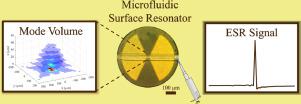Journal of Magnetic Resonance Open ( IF 1.5 ) Pub Date : 2020-08-13 , DOI: 10.1016/j.jmro.2020.100005 Nir Dayan , Yakir Ishay , Yaron Artzi , David Cristea , Benoit Driesschaert , Aharon Blank

|
Microfluidics is a well-established technique to synthesize, process, and analyze small amounts of materials for chemical, biological, medical, and environmental applications. Typically, it involves the use of reagents with a volume smaller than ~ 1 micro-l—ideally even nano- or picoliters. When the sample of interest contains paramagnetic species, it can in principle be quantified and analyzed by electron spin resonance (ESR) spectroscopy. However, conventional ESR is typically carried out with a sample volume of ~ 1 ml, thereby making it incompatible with most microfluidics applications. Here we show that by using a new class of miniature surface resonators combined with photolithography to prepare microfluidic patterns, ESR can be applied to measure small liquid samples, down to picoliter volumes, without considerably sacrificing concentration sensitivity. Our experiments, carried out with resonators whose mode volumes range from ~1 to 3.6 nL, showed that with a sample volume of ~0.25 nL good signals could be obtained from solutions with spin concentrations of less than 0.1 μM. The advantage of using microfluidics ESR is evident in our work, not only because it facilitates the use of a very small sample volume, but also because it makes it possible to apply huge ( ~ 1000 T/m) and fast ( ~ 1 μs) pulsed magnetic field gradients to the sample. This is a key capability to measuring unique properties such as nanoscale real-space diffusion and quantum spin diffusion. All our experiments are performed at room temperature, making our technique compatible with future microfluidics applications that might employ a complete system of compact resonators, microfluidic chips, miniature magnets, and a compact ESR-on-a-chip spectrometer. This could result in a completely new approach to processing and measuring paramagnetic liquid samples for use in a variety of chemical, biological, medical, and environmental applications.
中文翻译:

亚纳升液体样品的电子自旋共振微流体
微流体技术是一种成熟的技术,可以合成,处理和分析少量材料,用于化学,生物,医学和环境应用。通常,它涉及使用体积小于〜1微升的试剂(理想情况下甚至是纳升或皮升)。当目标样品包含顺磁性物质时,原则上可以通过电子自旋共振(ESR)光谱进行定量和分析。但是,常规ESR通常以约1 ml的样品量进行,因此使其与大多数微流体应用程序不兼容。在这里,我们表明,通过使用一类新型的微型表面谐振器与光刻技术结合来制备微流体图案,ESR可用于测量小至皮升体积的液体样品,而不会显着牺牲浓度灵敏度。我们对模式体积范围从〜1到3.6 nL的谐振器进行了实验,结果表明,在样品体积为〜0.25 nL的情况下,可以从自旋浓度小于0.1μM的溶液中获得良好的信号。使用微流体ESR的优势在我们的工作中显而易见,不仅因为它有助于使用非常小的样品量,而且还因为它使应用大体积(〜1000 T / m)和快速(〜1μs)成为可能。脉冲磁场梯度到样品。这是测量独特特性(如纳米级实空间扩散和量子自旋扩散)的关键能力。我们所有的实验都是在室温下进行的,使我们的技术与将来的微流体应用程序兼容,后者可能会使用紧凑型谐振器,微流体芯片,微型磁体和紧凑型单芯片ESR光谱仪的完整系统。这可能会导致一种全新的方法来处理和测量顺磁性液体样品,以用于各种化学,生物,医学和环境应用。











































 京公网安备 11010802027423号
京公网安备 11010802027423号